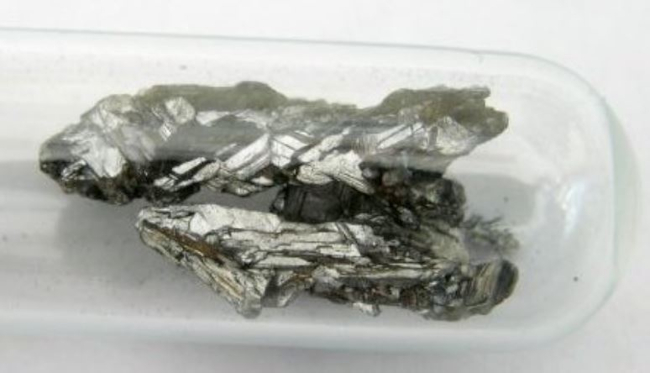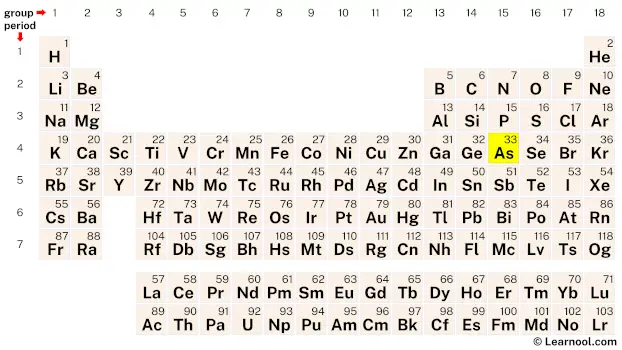
Arsenic (As) is a chemical element of the periodic table, located in the group 15 and the period 4, and is having the atomic number 33. It is a brittle, silvery-grey metalloid, whose name comes from the Greek word “arsenikon”, which means the yellow pigment orpiment. It has three allotropes: grey, yellow and black. It is a member of the pnictogen group.
On periodic table
| group | ⇨ | 1 | 2 | 3 | 4 | 5 | 6 | 7 | 8 | 9 | 10 | 11 | 12 | 13 | 14 | 15 | 16 | 17 | 18 |
| period | ⇩ | ||||||||||||||||||
| 1 | 1 H  Hydrogen |
2 He  Helium |
|||||||||||||||||
| 2 | 3 Li  Lithium |
4 Be  Beryllium |
5 B  Boron |
6 C  Carbon |
7 N  Nitrogen |
8 O  Oxygen |
9 F  Fluorine |
10 Ne  Neon |
|||||||||||
| 3 | 11 Na  Sodium |
12 Mg  Magnesium |
13 Al  Aluminium |
14 Si Silicon |
15 P  Phosphorus |
16 S  Sulfur |
17 Cl  Chlorine |
18 Ar  Argon |
|||||||||||
| 4 | 19 K  Potassium |
20 Ca  Calcium |
21 Sc  Scandium |
22 Ti  Titanium |
23 V  Vanadium |
24 Cr  Chromium |
25 Mn  Manganese |
26 Fe  Iron |
27 Co  Cobalt |
28 Ni  Nickel |
29 Cu  Copper |
30 Zn  Zinc |
31 Ga  Gallium |
32 Ge  Germanium |
33 As Arsenic |
34 Se  Selenium |
35 Br  Bromine |
36 Kr  Krypton |
|
| 5 | 37 Rb  Rubidium |
38 Sr  Strontium |
39 Y  Yttrium |
40 Zr  Zirconium |
41 Nb  Niobium |
42 Mo  Molybdenum |
43 Tc  Technetium |
44 Ru  Ruthenium |
45 Rh  Rhodium |
46 Pd  Palladium |
47 Ag  Silver |
48 Cd  Cadmium |
49 In  Indium |
50 Sn  Tin |
51 Sb  Antimony |
52 Te  Tellurium |
53 I  Iodine |
54 Xe  Xenon |
|
| 6 | 55 Cs  Caesium |
56 Ba  Barium |
72 Hf  Hafnium |
73 Ta  Tantalum |
74 W  Tungsten |
75 Re  Rhenium |
76 Os  Osmium |
77 Ir  Iridium |
78 Pt  Platinum |
79 Au  Gold |
80 Hg  Mercury |
81 Tl  Thallium |
82 Pb  Lead |
83 Bi  Bismuth |
84 Po  Polonium |
85 At  Astatine |
86 Rn  Radon |
||
| 7 | 87 Fr  Francium |
88 Ra  Radium |
104 Rf  Rutherfordium |
105 Db  Dubnium |
106 Sg  Seaborgium |
107 Bh  Bohrium |
108 Hs  Hassium |
109 Mt  Meitnerium |
110 Ds  Darmstadtium |
111 Rg  Roentgenium |
112 Cn  Copernicium |
113 Nh  Nihonium |
114 Fl  Flerovium |
115 Mc  Moscovium |
116 Lv  Livermorium |
117 Ts  Tennessine |
118 Og  Oganesson |
||
| 57 La  Lanthanum |
58 Ce  Cerium |
59 Pr  Praseodymium |
60 Nd  Neodymium |
61 Pm  Promethium |
62 Sm  Samarium |
63 Eu  Europium |
64 Gd  Gadolinium |
65 Tb  Terbium |
66 Dy  Dysprosium |
67 Ho  Holmium |
68 Er  Erbium |
69 Tm  Thulium |
70 Yb  Ytterbium |
71 Lu  Lutetium |
|||||
| 89 Ac  Actinium |
90 Th  Thorium |
91 Pa  Protactinium |
92 U  Uranium |
93 Np  Neptunium |
94 Pu  Plutonium |
95 Am  Americium |
96 Cm  Curium |
97 Bk  Berkelium |
98 Cf  Californium |
99 Es  Einsteinium |
100 Fm  Fermium |
101 Md  Mendelevium |
102 No  Nobelium |
103 Lr  Lawrencium |
|||||
| – p block |
Arsenic is a p-block element, situated in the fifteenth column and the fourth row of the periodic table, denoted by the atomic number 33 and chemical symbol As.
Element information
 |
|
 |
|
| Origin of name | Greek word “arsenikon” (which means yellow pigment now known as orpiment) |
| Symbol | As |
| Atomic number (Z) | 33 |
| Atomic mass | 74.9216 u |
| Block | p-block |
| Group | 15 (nitrogen group) |
| Period | 4 |
| Classification | Metalloid |
| Atomic radius | 119 pm |
| Covalent radius | 119±4 pm |
| Van der Waals radius | 185 pm |
| Sublimation point | 615 ℃, 1137 ℉, 887 K |
| Electron configuration | [Ar] 3d10 4s2 4p3 |
| Learn how to write: Arsenic electron configuration | |
| Electrons per shell | 2, 8, 18, 5 |
| Learn how to draw: Arsenic Bohr model | |
| Crystal structure | Rhombohedral |
| Phase at r.t | Solid |
| Density near r.t | 5.727 g/cm3 |
| Main isotopes | Arsenic-75 |
| Natural occurrence | Primordial |
| Oxidation state | -3, +3, +5 |
| Electronegativity (Pauling scale) | 2.18 |
| Protons Neutrons Electrons |
33 42 33 |
| Learn how to find: Arsenic protons neutrons electrons | |
| Valence electrons | 5 |
| Learn how to find: Arsenic valence electrons | |
| CAS number | 7440-38-2 |
| Discovered by | Arabic alchemists before AD 815 |
History
Arsenic has a rich and complex history, dating back to ancient times. The element was known to the ancient Greeks and Egyptians, who used its sulfide mineral, orpiment, as a pigment in their artwork. The name “arsenic” is derived from the Greek word “arsenikon,” which means “masculine,” as the element was used in ancient times as a component of cosmetics for men.
In the 13th century, Albertus Magnus, a German philosopher and theologian, was the first to isolate arsenic in its pure metallic form. The element was then used for medicinal purposes, including the treatment of skin diseases and syphilis, although its toxic properties were also recognized. During the 18th and 19th centuries, arsenic became increasingly popular as a poison, and was famously used in several high-profile murder cases.
In the 20th century, arsenic found a range of applications in industry, including as a wood preservative, in the production of pesticides and herbicides, and in the manufacture of electronics. However, the toxicity of arsenic also became more widely recognized during this time, and its use in many applications was restricted or banned. Today, arsenic and its compounds still find use in a range of industrial applications, including the production of semiconductors and glass, but their toxicity means that their use is closely regulated.
Occurrence and production
Arsenic is a naturally occurring element that is found in the Earth’s crust. It is not present in its pure form in nature, but rather in combination with other elements. Arsenic can be found in minerals such as arsenopyrite, realgar, and orpiment. It is also present in small amounts in soil, water, and air. Arsenic-containing minerals are often mined for commercial use.
Arsenic can be produced in several ways, including from the processing of arsenic-containing minerals, the roasting of metallic ores, and the smelting of copper and lead ores. The most common method for producing arsenic is by heating arsenopyrite in the presence of air, which oxidizes the arsenic and produces arsenic trioxide. This compound can then be further processed to produce metallic arsenic or other arsenic compounds.
In addition to these natural and industrial sources of arsenic, it can also be produced synthetically for use in various applications, such as semiconductor manufacturing and wood preservation. However, due to its toxic nature, the production and use of arsenic compounds are strictly regulated in many countries.
Properties
Arsenic is a solid element that exists in three allotropic forms: yellow, black, and gray.
The density of gray arsenic is 5.727 g/cm3.
Grey arsenic melts at 817 ℃ and boils at 615 ℃.
Arsenic is a highly reactive element and forms various chemical compounds with other elements. It reacts with metals, nonmetals, and metalloids to form arsenides, oxides, halides, and sulfides.
Arsenic is highly toxic to living organisms and can cause skin, lung, and bladder cancer, as well as various other health problems.
Arsenic is a semiconductor and has properties intermediate between those of metals and nonmetals. It has a negative temperature coefficient of resistance, meaning that its electrical resistance decreases as the temperature increases.
Applications
Wood preservative
Arsenic compounds have been used for many years to preserve wood. Arsenic-treated wood is resistant to rot and insect damage and has been used in construction, fencing, and other outdoor applications.
Pesticides
Arsenic compounds have been used as pesticides in agriculture to control pests and diseases in crops. Arsenic is particularly effective against termites, and it is used in some termite control products.
Glass manufacturing
Arsenic oxide is used in the manufacture of glass to decolorize it and make it clearer.
Medicines
Arsenic compounds have been used in traditional medicines for thousands of years to treat a variety of ailments, including skin diseases and digestive disorders. Arsenic-based drugs have also been used in the treatment of certain types of cancer.
Semiconductor industry
Arsenic is used in the production of semiconductors, particularly in the manufacture of gallium arsenide, a semiconductor material used in electronic devices.
Lead-acid batteries
Arsenic is used in the production of lead-acid batteries, where it acts as an alloying agent to improve the performance of the battery.
Pigments
Arsenic compounds have been used in the manufacture of pigments for paints, ceramics, and other applications. However, this use is now rare due to concerns about the toxicity of arsenic.
Military applications
Arsenic has been used in the production of certain types of ammunition, such as poison gas and smoke grenades. However, this use is now banned under the Chemical Weapons Convention.
Note: Arsenic is a highly toxic substance and its use is regulated in many countries. In some cases, its use has been banned or restricted due to health concerns.
Interesting facts
The name “arsenic” is derived from the Greek word “arsenikon” which means “yellow orpiment”.
Arsenic has been used for medicinal purposes for centuries, but it was also known as “the king of poisons” due to its toxic properties.
Arsenic is commonly found in minerals and ores, and it is also present in small amounts in the Earth’s crust, soil, and water.
Arsenic has been used as a pigment in glassmaking, ceramics, and textiles.
Arsenic has been used as a pesticide in agriculture, although its use has declined due to health concerns.
Arsenic is a component of some semiconductors and is used in electronic devices such as transistors.
Arsenic is also used in the manufacturing of some alloys, including lead shot for hunting.
Napoleon Bonaparte is said to have been poisoned with arsenic, which was found in his hair samples.
Arsenic trioxide has been used as a cancer treatment, although it is highly toxic and has been replaced by other treatments.
Arsenic is commonly found in rice, particularly in rice grown in certain regions, which can lead to health concerns for those who consume it regularly.
Related
More elements
External links
- https://www.rsc.org/periodic-table/element/33/arsenic
- https://www.britannica.com/science/arsenic
- https://pubchem.ncbi.nlm.nih.gov/element/Arsenic
- https://en.wikipedia.org/wiki/Arsenic
- https://education.jlab.org/itselemental/ele033.html
- https://www.chemicool.com/elements/arsenic.html
- https://www.ducksters.com/science/chemistry/arsenic.php
- https://www.livescience.com/29522-arsenic.html
Deep
Learnool.com was founded by Deep Rana, who is a mechanical engineer by profession and a blogger by passion. He has a good conceptual knowledge on different educational topics and he provides the same on this website. He loves to learn something new everyday and believes that the best utilization of free time is developing a new skill.
